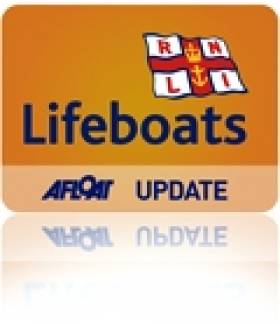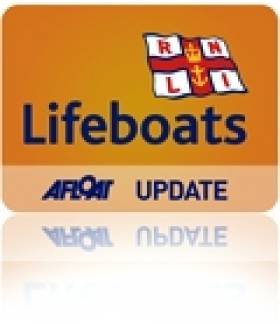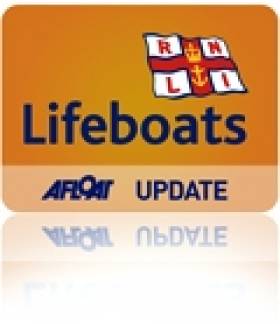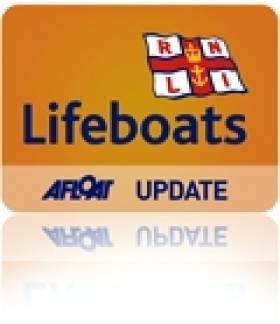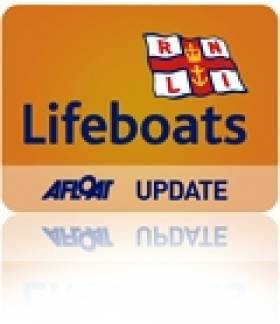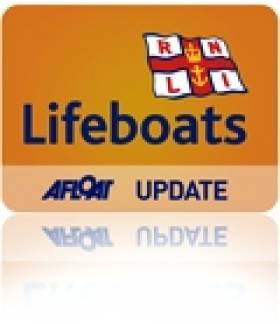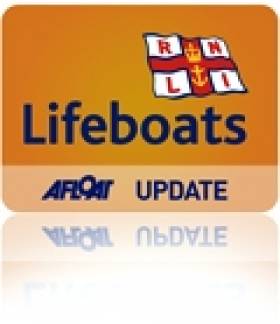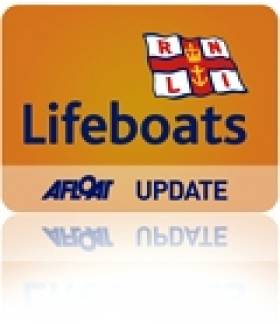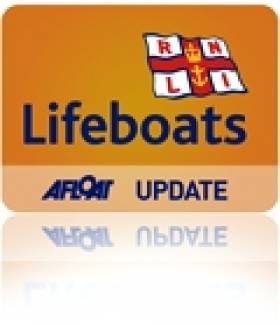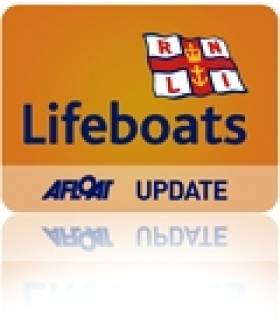Displaying items by tag: RNLI
Holyhead Lifeboat Rescues Kayakers From Irish Sea
#RNLI - Holyhead's all-weather lifeboat and volunteer crew launched on service to six kayaks in difficulty off Middle Mouse in the Irish Sea north of Anglesey in Wales last Sunday (20 October).
One of the party reportedly capsized and was in the sea for some time, but with help was recovered.
- Sea King helicopter from RAF Valley kept the party in sight until the lifeboat arrived. Cemaes Bay coastguard were also on shore watching and relaying information to the coastguard at Holyhead.
All the kayakers were rescued by the all-weather lifeboat from Holyhead RNLI and brought to the safety of Holyhead Marina.
Arranmore Lifeboat Crew Undergo Special First Aid Training
#RNLI - Life for the RNLI’s volunteer lifeboat crews doesn’t stop when they come ashore from a call-out. Once the lifeboat is safely back at anchor, the crew then attend training which ensures that each crew member can carry on saving lives at sea.
The Arranmore RNLI Lifeboat crew are currently attending a first aid course at their lifeboat station on the west Donegal island. Such competence-based training (or CBT) is an integral part of each crew member’s role in their life aving work on the lifeboats.
Each crew member can avail of training in various disciplines including navigation, boat handling, communications and at present first aid.
According the RNLI, the organisation prides itself on providing the best possible training for each crew member and is continually engaged in research to provide best practice for saving lives at sea.
Casualty care is a crucial link in the search and rescue (SAR) chain that allows lifeboat crews to save lives at sea. Having utilised their previously learned skills to save lives and rescue casualties at sea, continued training assists crew members to provide casualties with the best possible chance of survival, often in a hostile, unforgiving environment and many miles from professional hospital-based care.
Maritime SAR medicine is a specialised field, and the RNLI provides a bespoke course that prepares crew to manage any emergency encountered in the operational field of the RNLI.
The first aid course being provided to RNLI crew members throughout Ireland and the UK at the moment is specifically designed to depart as far as practical from the mainstream occupational first aid courses and focus on providing crew members with the maximum amount of knowledge to deal with emergencies at sea.
The training has a hands-on approach rather than complex theory or diagnosis, and empowers crew members to confidently and competently treat casualties. This approach is reinforced by a unique treatment check card, which takes the guesswork out of treating casualties.
The type of emergencies lifeboat crews deal with are, at a basic level, similar to emergencies one encounters on shore, and can involve loss of limbs, burns, breathing difficulties and heart problems - but are sometimes many miles from a mainland hospital, and only the expertise of the lifeboat crew (without having to rely on memory, because of the card reference system operated by the RNLI) can mean the difference between life and death.
The course is accredited by the RNLI Medical and Survival Committee and the Trauma and Critical Care Group, and is approved by the Royal College of Surgeons and the paramedic department. The system itself is highly regarded by many other emergency services as it is being continually reassessed and upgraded.
The course is delivered at a time and place, usually at the local lifeboat station, that’s convenient to crew members and is the last of this course to be delivered prior to the next upgrade in January 2014. The new changes will include a portable stretcher that can be accommodated in the smaller class inshore lifeboats; the introduction of the use of drugs to alleviate breathing difficulties; the use of more user-friendly check cards; and the reassessment of the treatment of head injuries at sea.
RNLI trainer Trevor Stevens said: “The training which crew members receive is specially designed so that each crew member is guided by the same protocols no matter where, within the spectrum of the RNLI, they operate.
“We are confident that our voluntary crew can competently deal with any emergency, large or small to a high standard and it is the aim of the RNLI to provide the best possible training to our voluntary crew.”
Howth Yacht Club Hosts RNLI Annual Supporter's Meeting
Howth RNLI Annual Supporter's meeting will be held in Howth Yacht Club on Wednesday 6 November at 8pm.
The meeting is an opportunity to thank those who have supported Howth Lifeboat station, give them a chance to meet the crew and update supporters on how their donations have contributed to saving lives at sea.
There will be a presentation of a Lifeboat Crew Awards to a crew member who has shown great skill and expertise. Certificates will also be awarded to groups and individuals who have carried out fundraising in aid of the RNLI. Ronan Murphy and the team in Toned Fit took part in and brought their StaminUp group to the Hell & Back Challenge in February. Gavin Pitcher of City Kayaking who organised the Dublin City 5km Kayaking Challenge in April. Jennifer Murphy and Brendan Mulligan cycled from London to Paris in aid of Howth RNLI in August. Louise Wolff one of our newest crew members, is taking part in the Dublin Marathon to raise funds.
RNLI Christmas Cards and souvenirs will be on sale on the night, and supporters can find out more about the RNLI Reindeer Run to be held in Marlay Park on Sunday 1 December
Cork Vocal Group Raises Funds For Crosshaven RNLI
#RNLI - The Cork City-based Cantabile Vocal Ensemble visited Crosshaven lifeboat station recently to present a cheque for €775 to the RNLI.
The institution is one of three charities that received donations from funds raised at an open-air concert held at Fort Meagher in Crosshaven during the summer.
Crosshaven RNLI chairman Barry Woods received the cheque on behalf of the RNLI and at a short presentation outlined the work of the volunteer crew and the value of donations to the charity.
"We would like to thank the Cantible Vocal Ensemble for thinking and including the RNLI in their fundraising," he said.
Baltimore Lifeboat Rescue to Feature in RNLI's World War One exhibition
#rnli – The role of Baltimore in the rescue of 23 people from a steamship called Alondra which was wrecked off the West Cork village in late 1916, is to be featured in an RNLI touring exhibition commemorating the centenary of World War One (WW1). The charity's exhibition, funded by Arts Council England, is called Hope in the Great War and will honour the courage and bravery of the lifeboat crew who risked their lives to save others during WW1.
While a lot of people will be familiar with the sinking of the Lusitania off the Cork coast in 1915, not as many will be aware of this rescue which took place in Baltimore a year later.
A decision by the RNLI charity to establish a lifeboat station at Baltimore was made in 1913 but its actual opening took place in 1919, having been delayed by the First World War.
It was on the 29 December 1916 that the SSAlondra was wrecked on the Kedge Rock, off Baltimore. Sixteen of her crew left in one of the ship's boats, but drowned before reaching the shore. The Venerable Archeacon John Richard Hedge Becher (Honorary Secretary of Baltimore RNLI) and some volunteers launched a boat but it failed to reach the vessel. They returned to Baltimore but put off again as some of the ship's crew had made the rock. Failing to reach the wreck they put back to shore again. At daylight they set out with rocket apparatus. About the same time, two Royal Navy trawlers came upon the scene and the efforts of all, saved 23 survivors some of whom were lowered down a 150 foot cliff.
RNLI Silver Medals for Gallantry were awarded to Archdeacon Becher and Lieutenant Sanderson for their role in helping to rescue the 23 men fromAlondra.
Baltimore's lifesaving story has been chosen to feature alongside five other RNLI lifeboat services that took place in communities across Ireland and the UK. Opening in February 2014 at the Henry Blogg Museum in Norfolk, Hope in the Great Warwill start a four year tour around RNLI museums, lifeboat stations and other museums.
Now the RNLI is asking the local community in Baltimore to get in contact if they know of any details such as family memories, photographs, letters or artefacts connected to the rescue. The most relevant items may be selected to feature within the exhibition allowing the fullest story of the rescue to be told nationally.
Becky Fletcher, RNLI Heritage Project Co-ordinator said: 'The outstanding efforts by Baltimore's RNLI volunteers to save lives in WW1 will now be given a voice. Although little details are known about the SSAlondra rescue, finding any connections would undoubtedly be of further inspiration.'
To pass on any family memories, anecdotes, photos or letters, please [email protected] or call the RNLI Henry Blogg Museum on 01263 511294.
Locally meanwhile, Baltimore RNLI is teaming up with members of the Baltimore Amateur Drama Group to create a piece of artwork for the tour. The group is creating a short film about the rescue which will feature within the exhibition.
Olan Marten, spokesperson for the drama group explains: 'With so many members of the RNLI supporting our productions over the years, as either cast members, crew or audience it is a great honour to do something for them and also to honour the brave men involved in the Alondra rescue. It's an unusual production as the crew and the director will meet for the first time on the first day of filming. Not only that but the film will travel all over Ireland and the UK for four years introducing these local amateur actors to a huge audience.'
Baltimore RNLI will be the second Cork lifeboat station to mark the role it played during World War One. The Courtmacsherry RNLI Lusitania Centenary Committee has already appealed to the public for artefacts, stories and memorabilia to be part of a major exhibition to commemorate the centenary of the sinking of the Lusitania off the Cork coast in 1915. They are also calling on any family members of those lost or saved in the Lusitania tragedy to contact them to share their stories, which will then be compiled and included in the exhibition.
The commemoration will be held on the May Bank holiday weekend 2015 with the centrepiece being a Lusitania Exhibition in Courtmacsherry RNLI Lifeboat Station and other local venues. Courtmacsherry lifeboat responded to the tragedy in 1915 and to coincide with the exhibition, the lifeboat crew will re-enact the call to service and row out to the site of the disaster.
Red Bay Lifeboat Recovers Body From Antrim Coast
#RNLI - Red Bay RNLI was involved in the recovery of a man’s body off the Antrim coast yesterday (Friday 11 October).
The volunteer lifeboat crew was requested to launch its inshore lifeboat at 4pm, and they recovered the body from the water south of Glenarm.
Red Bay RNLI lifeboat operations manager Andrew McAlister said: "We can confirm that the lifeboat crew recovered a body this afternoon. Red Bay RNLI would like to extend its sympathy with the family of the deceased."
In more positive news, members of the Hegarty family - who lost two brothers to the sea in separate incidents over the years - raised €315 for Crosshaven RNLI at the Cork Evening Echo Mini Marathon recently.
Cousins Anna Hegarty and Abbey O'Brien received a tour of the lifeboat station and took away gifts presented to them by the crew.
Baltimore Lifeboat Rescue To Feature In RNLI Great War Exhibition
#RNLI - The role of Baltimore in the rescue of 23 people from the steamship Alondra, wrecked off the West Cork village in late 1916, is to be featured in a touring RNLI exhibition commemorating the centenary of the First World War.
Hope in the Great War, funded by Arts Council England, will honour the courage and bravery of the lifeboat crew who risked their lives to save others during WWI.
While many will be familiar with the sinking of the Lusitania off the Cork coast in 1915, fewer will be aware of this rescue, which took place in Baltimore a year later.
A decision by the RNLI charity to establish a lifeboat station at Baltimore was made in 1913 but its actual opening took place in 1919, having been delayed by the war.
It was on the 29 December 1916 that the SS Alondra was wrecked on the Kedge Rock, off Baltimore. Sixteen of her crew left in one of the ship’s boats, but drowned before reaching the shore.
The Venerable Archeacon John Richard Hedge Becher - honorary secretary of Baltimore RNLI - and some volunteers launched a boat but it failed to reach the vessel. They returned to Baltimore but put off again as some of the ship’s crew had made the rock. Failing to reach the wreck, they put back to shore again.
At daylight they set out with rocket apparatus. About the same time, two Royal Navy trawlers came upon the scene and the efforts of all, saved 23 survivors some of whom were lowered down a 150-foot cliff.
RNLI Silver Medals for Gallantry were awarded to Archdeacon Becher and Lieutenant Sanderson for their role in helping to rescue the 23 men from Alondra.
Baltimore’s lifesaving story has been chosen to feature alongside five other RNLI lifeboat services that took place in communities across Ireland and the UK.
Opening in February 2014 at the Henry Blogg Museum in Norfolk, Hope in the Great War will start a four-year tour around RNLI museums, lifeboat stations and other museums.
Now the RNLI is asking the local community in Baltimore to get in contact if they know of any details such as family memories, photographs, letters or artefacts connected to the rescue. The most relevant items may be selected to feature within the exhibition allowing the fullest story of the rescue to be told nationally.
RNLI heritage project co-ordinator Becky Fletcher said: “The outstanding efforts by Baltimore’s RNLI volunteers to save lives in WW1 will now be given a voice. “Although little details are known about the SS Alondra rescue, finding any connections would undoubtedly be of further inspiration.”
To pass on any family memories, anecdotes, photos or letters, please email [email protected] or call the RNLI Henry Blogg Museum on 01263 511294.
Locally, meanwhile, Baltimore RNLI is teaming up with members of the Baltimore Amateur Drama Group to create a piece of artwork for the tour. The group is creating a short film about the rescue which will feature within the exhibition.
Olan Marten, spokesperson for the drama group, said: “With so many members of the RNLI supporting our productions over the years, as either cast members, crew or audience it is a great honour to do something for them and also to honour the brave men involved in the Alondra rescue.
“It’s an unusual production as the crew and the director will meet for the first time on the first day of filming. Not only that but the film will travel all over Ireland and the UK for four years introducing these local amateur actors to a huge audience.”
Baltimore RNLI will be the second Cork lifeboat station to mark the role it played during the First World War.
The Courtmacsherry RNLI Lusitania Centenary Committee has already appealed to the public for artefacts, stories and memorabilia to be part of a major exhibition to commemorate the centenary of the sinking of the Lusitania off the Cork coast in 1915.
They are also calling on any family members of those lost or saved in the Lusitania tragedy to contact them to share their stories, which will then be compiled and included in the exhibition.
The commemoration will be held on the May Bank holiday weekend in 2015, with the centrepiece being a Lusitania Exhibition in Courtmacsherry RNLI Lifeboat Station and other local venues.
Courtmacsherry lifeboat responded to the tragedy in 1915 - and to coincide with the exhibition, the lifeboat crew will re-enact the call to service and row out to the site of the disaster.
Youghal RNLI Marks 175 Years With 2014 Calendar
#RNLI - Youghal RNLI is to launch a 2014 calendar to mark the 175th anniversary of the establishment of the lifeboat station, which has been serving the areas around East Cork and West Waterford since 1839.
A photographic trawl from past to present, combined with a scattering of insightful facts, makes this calendar a fascinating study of the station’s rich history.
The calendar takes us from humble beginnings when the first lifeboat station was built at a cost of £100 back in 1857, right up to the present day where we see the current state-of-the-art station that’s home to an Atlantic 75 inshore lifeboat and continues to be crewed by the community’s volunteers.
Since the station was established, Youghal RNLI has launched 504 times, saving the lives of 213 people and rescuing a further 362.
Published by Youghal RNLI and their fundraising branch, the calendar will be launched at 7.30pm on Sunday 20 October at the Mall Arts Centre in Youghal.
Speaking ahead of the launch, Youghal RNLI volunteer lifeboat press officer Noreen Varney said: “The original idea for the calendar came about following a discussion between crew members Joe Moore, Brendan O’ Driscoll, myself and fundraising secretary Susan Mason. We thought it would be a great idea given that we would be celebrating our 175th anniversary in 2014.
“Once we had decided to go for it, we asked our local businesses to sponsor the project and we are indebted to them for their support."
Varney added that the photos included “are a combination of the lifeboats we have had in Youghal throughout the 175 years and the crews that have served them. The photos were taken by various people and we are grateful to them too for their input.
“We hope the calendar will make way for a nostalgic 2014 as readers peruse the photos and savour the short snippets of history month after month. The proceeds raised from the sales of the calendar will help us to continue to save lives at sea."
The calendar - simply entitled Youghal Lifeboat Calendar 2014, will be available to purchase locally in Read & Write, Cree’s card shop, Muckley’s Jewlellers, Crowley’s service station, Galvin’s CostCutters, Country Stores Kinsalebeg, Centra in the Strand, Centra in Killeagh, J Coleman in Killeagh and the Youghal Lifeboat Souvenir shop for €10, or alternatively by contacting Noreen at 087 050 6640 or [email protected].
Fisherman Rescued By RNLI Crew Meets His Rescuers - And Owes His Life To Lifejacket Initiative
#RNLI - A fisherman whose boat sank in minutes has thanked several organisations who implemented and trained him on using a lifejacket for saving his life.
Samuel Cully, a fisherman from Portavogie, was in the water for 45 minutes after his vessel sank on Wednesday 18 September, off the coast of Co Down. Weather conditions at the time were rough seas with Force 5 to 6 winds blowing.
RNLI lifeboats from Portaferry and Donaghadee were launched within minutes of a May Day being received by the Belfast Coastguard, along with the Irish Coast Guard helicopter Rescue 116.
Recently Cully was reunited with the volunteer crew at Portaferry who rescued him.
Just weeks earlier, Cully had been provided with a personal flotation device in a grant-aided scheme run by the Fishermen’s Mission with funding and support from Seafish, the Department for Agriculture and Rural Development through the European Fisheries Fund, the Northern Ireland Fish Producers Organisation, RNLI, the Maritime Coastguard Agency and supermarket Asda.
The project aims to ensure that fishermen will receive a grant-aided PFD and the training required to ensure its proper use.
Frankie Horn, RNLI fishing safety manager for the UK and Ireland, said: "It’s great that Samuel is safe, and back with his family. We want fishermen to see the benefits of wearing a personal flotation device or lifejacket and for them to wear it voluntarily.
"This will be an ongoing process for us, talking to fishermen and working with the manufacturers to ensure that the PFDs provided are the best possible design for the fishing industry."
With the funding and logistics generously covered by other agencies, the RNLI was involved in leading the safety training session – an act that Cully is immensely grateful for.
"I was only able to swim five or ten metres or so, and even then the wind and swell were washing me away from the shore," he recalled. "The boat went down so quickly, and I was so relieved to find the lifejacket doing exactly what I was told it would do. I cannot thank all those organisations involved enough."
In more recent news, Donaghadee and Portaferry RNLI launched yesterday (Tuesday 8 October) to go to the aid of a man fishing off rocks who became stranded by the tide.
Belfast Coastguard had received a call from a member of the general public just after 10.20am alerting them of the emergency.
On arriving on the scene, Donaghadee's all-weather lifeboat crew found their colleagues from Portaferry RNLI's inshore lifeboat were taking the man off the rocks and returning him safely into Portavogie harbour.
Dun Laoghaire Lifeboat Rescues Three After Trawler Blaze
#RNLI - Three crew on a disabled fishing trawler were brought to safety by Dun Laoghaire RNLI today (Friday 4 October) after a fire broke out on board the 50-foot vessel.
The incident occurred off Bray Head at 10.30am when the Irish Coast Guard service at Dublin requested the launch of the all-weather lifeboat, which arrived on scene less than 30 minutes later.
The crew on the trawler were able to extinguish the fire but had no power to return to shore.
The lifeboat took the vessel under tow back to Dun Laoghaire in a two-hour operation. Nobody was injured in the incident.


























